Review of the 2023 Audi e-tron GT

The brand-new Audi e-tron GT immediately claims the title of the most potent series production Audi ever produced, much like so many cutting-edge all-electric vehicles from established names and up-and-coming manufacturers today. The Audi e-tron GT quattro and its top-tier RS e-tron GT stablemate use two electric motors with a 93.4kWh battery, and under full boost, are capable of producing up to 475kW and 830Nm (390kW/630Nm for the regular e-tron GT). They are built on the same shared J1 electric car platform as their ballistically quick Porsche Taycan cousin.
Also, both models have the identical two-speed transmission, which aids in launches requiring you to take off your sunglasses while Dynamic drive mode is engaged. You must hold on tightly if you’ve never launched a high-powered electric vehicle. Onto those Ray-Bans, and any version of the e-tron GT is no different.
But, some may consider Audi’s lower driving range a disadvantage compared to vehicles like the BMW i7 (625 km) or the Tesla Model S (652 km) — if only you could get one here. The e-tron GT advertises a maximum range of 504 kilometres for the base model (NEDC) and 540 kilometres for the RS. Still, it has the advantage of being able to recharge at 270 kW using DC charging, which allows for a 100-kilometre top-up in just five minutes.
Also, it’s the first battery-powered Audi ever to sport the coveted RS badge and uses the innovative engineering know-how of the high-performance Audi Sport division. This is a capable four-door sedan that can easily dominate your favourite fast-flowing curves without giving anything away.
There will undoubtedly be those who compare the Audi e-tron GT and Porsche Taycan based solely on acceleration. Still, the two vehicles’ distinct looks should make it abundantly evident that they provide pretty different performance options that should appeal to entirely different types of customers.
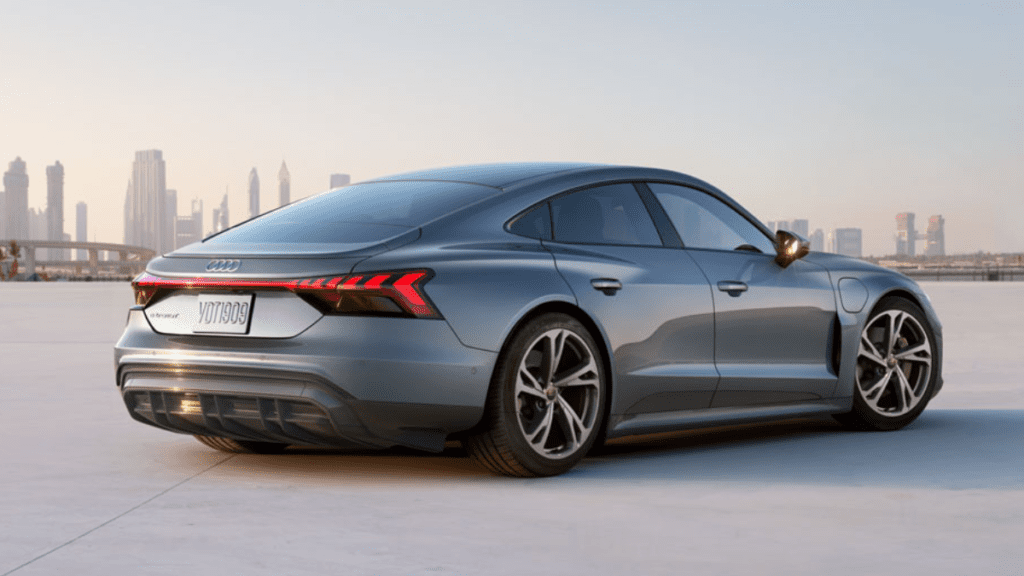
The Porsche is an all-electric sports car with a futuristic appearance intended to appeal to the well-heeled enthusiast ready to give up traditional combustion-engined sports cars for a new era of high-performance driving free from gas stations and expensive fuel. Another possible scenario is that they have one foot in each garage door.
The Taycan may take some time for non-auto enthusiasts to recognize as a Porsche, but no one, enthusiast or not, can mistake the e-tron GT for anything other than an Audi. One of the most attractive Audis ever made, perhaps perhaps. Whatever your opinion, its gorgeous design gives a more understated hint to the future of high-performance driving than its styled Taycan sibling. It is long, broad, and ultra-low-slung with a suitably robust posture.
The head of Audi Design, Marc Lichte, is known for designing many other vehicles, such as the Volkswagen Arteon and VW Golf Mk 5, 6, and 7. Still, he considers the Audi e-Tron GT “the most beautiful automobile that I have ever developed.” There is no debating this.
The closed-off grille, which replaces what would typically be Audi’s recognizable single-frame design on an ICE car with an attractive, if not futuristic, graphic, is the first obvious clue that an electric motor powers the vehicle.
The horizontal panel below has active slats for cooling and airflow, as well as cameras and radar, and it helps the e-tron GT achieve a drag coefficient of 0.24. It’s interesting to note that the e-tron GT is even lower than the lightning-fast Audi RS7.
The 21-inch, diamond-turned aero-styled alloy wheels on the RS variant and the 20s on the standard model contribute to the ground-hugging stance of the e-tron GT. But, the 20s on the standard model are also adequately modern and beautifully fill the wheel arches.
The RS e-tron GT, which we spent the most time in, is perhaps my favourite point-of-view out back, especially when it is painted Tango Red. The backlights and graphics are amazing but even more impressive at night when they do an on-off light show. Moreover, a concealed rear spoiler deploys at two different angles based on the vehicle’s speed. At 90 km/h, it is in its aerodynamic mode; nevertheless, at 170 km/h, it generates downforce.
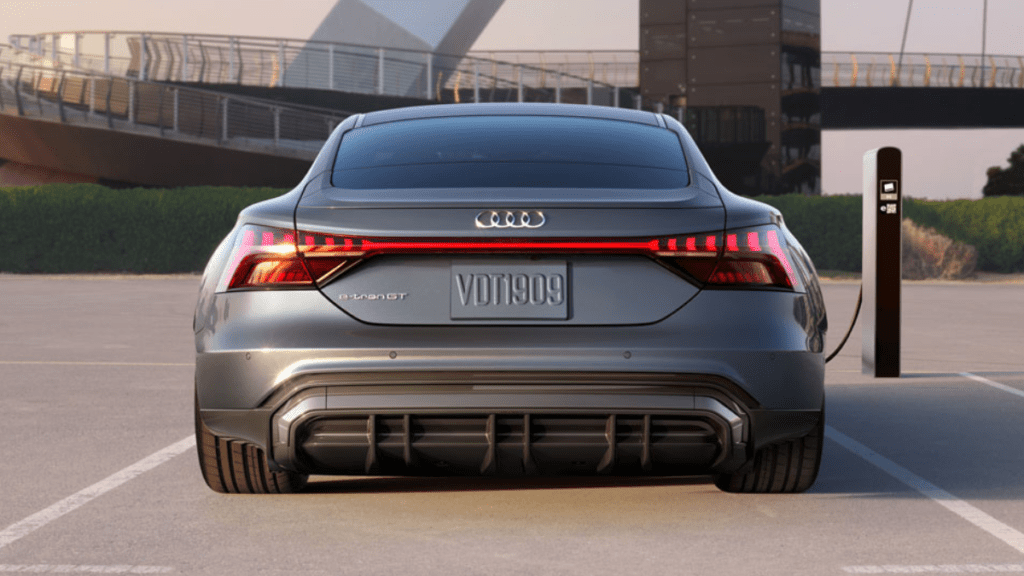
A serious-looking diffuser with further aerodynamic benefits is located below the decks. Either version’s carbon exterior kit includes a carbon roof and a full black pack with the Audi rings. It is more expensive than ceramic brakes, starting at a minimum of $15,000, but it does have an excellent appearance. Except for the carbon roof, all panels are made of aluminium. Hot-stamped steel and thicker aluminium extrusions create a sturdy crash structure.
With triple-chamber air suspension as standard on the e-tron GT, the lightweight concept is continued with cast-alloy suspension towers. Thanks to this feature, the automobile can be lowered by up to 22mm and as little as 10mm. The Audi e-tron GT’s floor is completely flat on the bottom. Still, hundreds of meticulously placed, shaped inputs have similar aerodynamic capabilities to the dimples on golf balls. It’s incredible how much detail was paid.
The e-tron GT looks quick even when stationary, and as its GT logo makes clear, it is a true Gran Turismo. Although not quite as warp-speed speedy as the Taycan Turbo S, it is also swift, especially in RS trim. But rest assured; it does fast EV luxury quite well. While sharing a platform with the Taycan, it’s interesting that the e-tron GT isn’t even produced there.
In contrast to the Taycan’s specialized manufacturing line at Zuffenhausen, the e-tron GT is constructed alongside Audi’s mid-engined R8 supercar at its Neckarsulm factory, leading one to believe that there may be a limit to the overall number of e-tron GTs Audi can efficiently produce.
However, Porsche also offers a more affordable entry-level model with rear-wheel drive, whereas the Audi boasts quattro all-wheel drive as standard on both e-tron models. This alone may have the effect of billing the e-tron GT as something more exclusive than the Taycan despite being significantly less expensive overall.

What is the price of the Audi e-tron GT?
The entry-level Audi e-tron model, the e-tron GT quattro, starts at $180,200 plus applicable taxes, while the quicker RS e-tron GT is priced at $248,200 before taxes.
Price of the 2023 Audi e-tron GT:
- $180,200 Audi e-tron GT quattro
- $248,200 Audi RS e-tron GT
- Costs don’t include tolls.
When comparing like-for-like performance specifications, the Porsche Taycan is more expensive unless you choose the base rear-drive model, which has a starting price of $158,100 and is slightly cheaper than the standard e-tron GT.
The Taycan 4S, which starts at $197,200 before on-road costs, is the Porsche counterpart to the standard e-tron GT, while the Taycan Turbo, which starts at $280,300 in Australia, is the Porsche equivalent to the RS e-tron GT.
How does the interior of the Audi e-tron GT look?
Both variants of Audi’s all-electric four-door coupe are exceptionally well-equipped with various high-end equipment and amenities as standard – it’s an entirely opulent cabin in every way. But, most of our time was spent driving the top RS e-tron GT.
But consider this: Audi owners switching from ICE to EVs will feel right at home in the driver’s seat of the e-tron GT because it looks and feels like any other top-shelf Audi at comparable high price points.
That’s a different offering from the Porsche Taycan, which seamlessly integrates its futuristic exterior design into the cabin for a next-generation experience, albeit one that isn’t quite as plentiful as switching from one Audi to another or from any other ICE-branded car to a luxury EV like the e-tron GT, there is something to be said for the familiarity of features and ergonomics.

Any day, the mix of the most excellent Nappa leather sports seats in the industry, brushed metal brightwork, and expanses of Alcantara with contrast red stitching is enticing. Audi’s patented dual-screen setup features a sizable, programmable digital instrument cluster, a head-up display, and a touchscreen infotainment screen. The 16-speaker B&O audio system is exceptional for its range of highs and lows and overall clarity. It comes standard on even the base model.
Although everything is well done, as we’ve come to expect from high-end Audis, and I enjoy how Audi handles the electronic shifter, you could have trouble finding enough room in the console up front for your keys, wallet, and sunglasses.
The centre-console bin contains a hidden wireless charging cradle, but you’ll need to practice inserting it a few times before it becomes second nature. The flat-bottomed Alcantara steering wheel in our RS e-tron sample is excellent in both comfort and grip, even though I’m not usually a fan of the material (too firm and less grip in the hands than a friendly leather-wrapped version).
Even for a high-speed Audi EV, the driving position is lower and more profound than you may anticipate. Still, once you get in and prepare for a full-scale assault on the twisties, you’ll fall in love with it thanks to its incredible performance capabilities. If I’m being sincere, the fit and feel are highly driver-centric and even a little Porsche-like.
The view from the letterbox window out back is one thing, but forward vision over that vast bonnet is excellent for accurately placing the car on the road. In constrained spaces, parking sensors and cameras are required. Taller frames above 190cm may have trouble finding enough headspace in the second-row seating, but there is plenty of legroom and elbow room.
Regarding available litres, the boot isn’t exceptionally roomy either (350L for the RS e-tron and 405L for the standard version). Still, we could fit many soft bags inside throughout our drive. See also Audi A4 Avant Estate
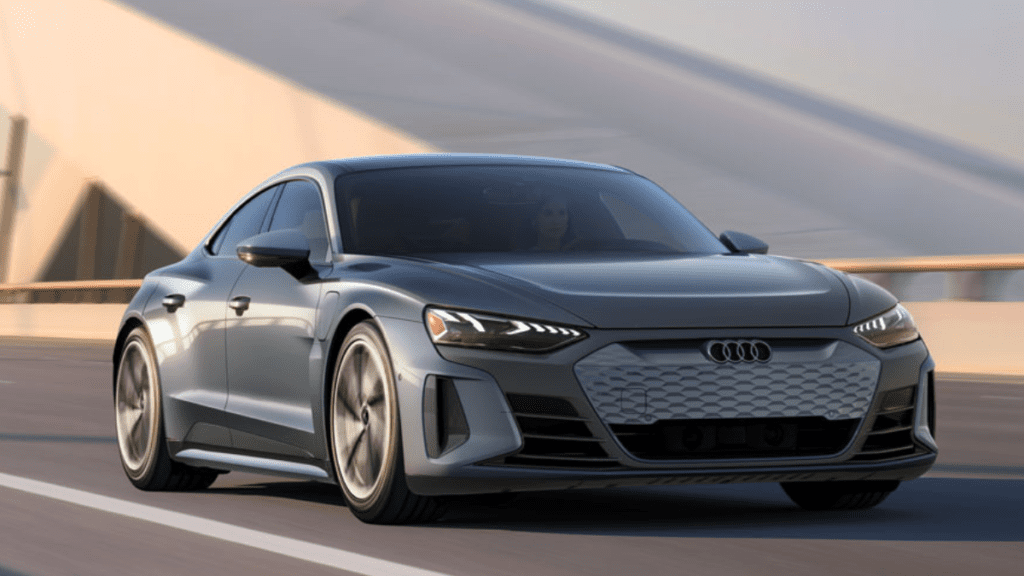
What powertrain does the Audi e-tron GT have?
With dual electric motors—one up front and one down back—and all-wheel drive via a two-speed transmission, the Audi RS e-tron GT and standard e-tron GT quattro both employ a 93.4kWh battery (net capacity of 83.7kWh) (like the Taycan).
The standard e-tron GT can accelerate from 0 to 100 km/h in 4.1 seconds thanks to its 350kW power (390kW in boost mode) and 630Nm of torque. The more potent RS e-tron GT produces 440kW (475kW in boost mode) and 830Nm and can accelerate from 0 to 100 km/h in 3.3 seconds.
Although both models claim a WLTP driving range of 488km, Audi states that the basic e-tron GT and the RS e-tron GT have a range of 540km (NEDC) and 504km, respectively. According to local specifications, the regular e-tron GT consumes 19.2kWh per 100km, and the RS e-tron GT consumes 20.2kWh per 100km.
Audi provides a 22kW three-phase charger as an option, increasing both the onboard charger and the external charger to 22kW capacity. e-tron GT purchasers will receive a 7.2kW single-phase wall charger box as standard.
The 800V electrical architecture of the e-tron GT also supports up to 270kW DC rapid charging, which can increase the battery’s capacity from 5% to 80% in 22.5 minutes and provide 100km of range in five minutes. The good news is that Audi will give unlimited charging at its ultra-rapid, fast, and standard charging locations for a free six-year subscription to the Chargefox charging network to all e-tron GT purchasers.
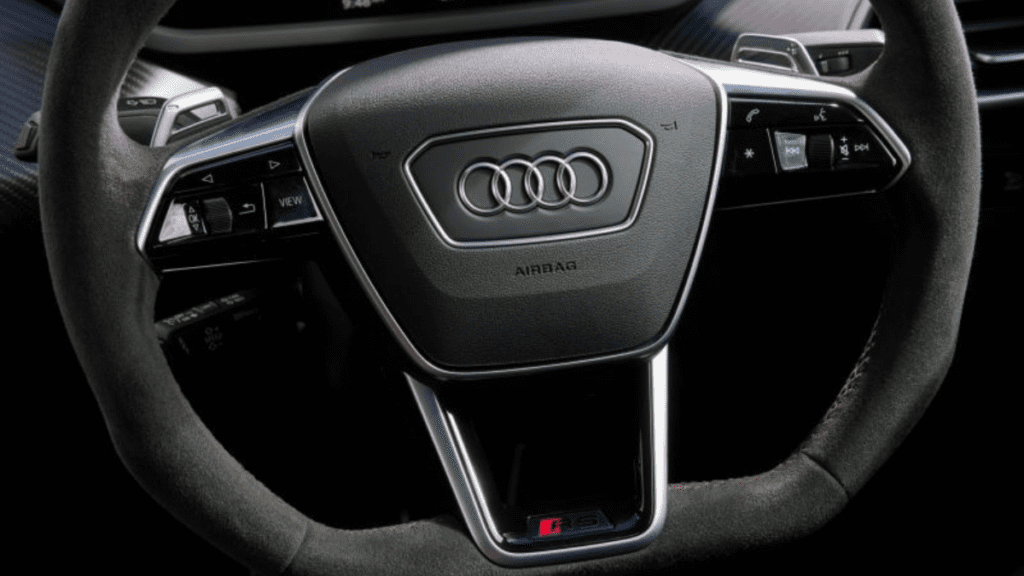
The Audi e-tron GT’s driving characteristics.
By chance, we were given the RS e-tron GT to drive first and spent most of the ambitious program in and around the NSW Snowy Mountains region, spending very little time in the regular e-tron GT.
As the e-tron GT has a three-chamber air suspension, it makes sense that you start in the least aggressive Comfort drive mode to gauge response times and ride compliance.
But, we turned on Dynamic mode for the quickest throttle response and rock solid chassis control when we came across some excellent rolling-hills terrain in this area, luring us with the promise of clean roads ahead and a dry surface (following the storm on the way down).
Despite weighing in at 2345 kg and a little less for the e-tron GT, you quickly realize how nicely balanced this car is when you accelerate at a good clip. Despite this, it has an excellent steering feel and feels firmly planted and surefooted when changing directions quickly. Even the Taycan seems more natural than most other EVs I’ve driven when weighing in the centre and the rack.
The RS e-tron GT’s all-wheel steering and e-quattro performance differential with torque vectoring further improve the driving dynamics. With that ICE-like feeling at the wheel, it seems more stable through the turns than the best Audis I’ve ever driven. In terms of acceleration, steering, and braking, it is entirely linear, which I wasn’t anticipating from the RS e-tron GT. But, the standard e-tron GT is notably less responsive, especially regarding steering.
Because all-wheel steering is not included in the standard trim, it may be worthwhile to purchase it as part of the extra Dynamic Plus Package, including a sport differential, torque vectoring, and stronger carbide brakes.
Yet, unlike Porsche Taycan, Audi has not fully embraced the one-pedal driving style. Only two stages of regen are possible in the Audi with the left-hand paddle shifter. Still, from my perspective, they barely register and have a negligible impact on how quickly the car slows down when you release the brake pedal properly.
Some people would find that soothing in the switch to an all-electric high-end Audi, but it’s far from enough for my taste, and I can’t help but think more is better with this class of EV. At the very least, it distinguishes the driving experiences of the e-tron GT and Taycan from other high-performance EVs. Nonetheless, you can’t knock on the comfort of the trip. The air suspension has enough compliance, even in the most severe Dynamic mode, to soften minor potholes without shaking the car.
The ease and speed you can move around in a luxury GT car are astonishing. Any sadness regarding the absence of regen brakes is considerably overshadowed by the utterly natural calibration of all the primary settings.
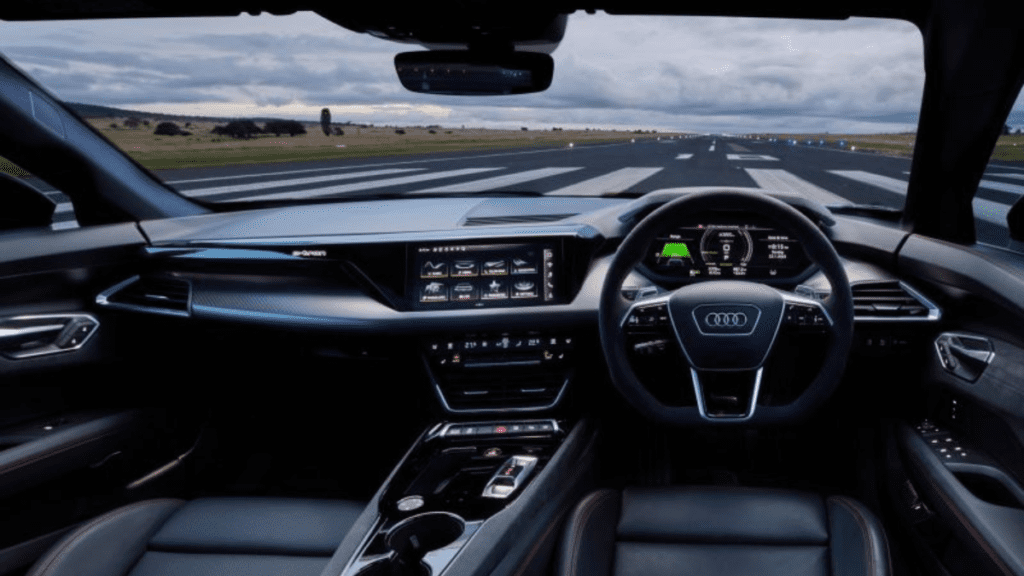
What do you get?
Highlights of the e-tron GT
- Chargefox network subscription for six years
- Wall-mountable 11 kW AC home charger
- 10.1-inch touchscreen information display device
- 12.3-inch digital instruments for the virtual cockpit
- Wireless Android Auto, Apple CarPlay, and Qi wireless phone charging
- 16-speaker Sound system in 3D by Bang & Olufsen
- digital radio DAB+
- Satellite navigation with a head-up display
- Air suspension that adjusts
- an expansive glass roof
- Matrix Audi laser light with LED headlights
- monitoring of tire pressure automatic headlights
- Wipers with a rain sensor
- Keyless start and entrance
- the automatic power boot lid
- a three-zone climatic system
- Power-folding, heated exterior mirrors
- Jets in a heated washer
- Leather furniture
- adjustable power front seats
- front chairs with heat
- Shift paddles
- instrument cowl, door inserts, and console surround upholstered in leatherette
- Grey interior inlays in graphite
- alloy 20-inch wheels
RS e-tron GT furthers:
- All-wheel steering
- Controlled rear differential lock
- Body-colour grille
- Nappa leather upholstery
- Colour ambient lighting
- Heated steering wheel
- Ventilated front seats
- 4-way lumbar support
- Extended Nappa leather/Dinamica interior upholstery
- Carbon twill inlays
- RS e-tron sport sound
- 21-inch alloy wheels
Options
Moreover, the e-tron is offered with six extra packages for modifications to the dynamics and trim: Exterior style in carbon and black costs $17,500 for the e-tron GT and $15,000 for the RS e-tron GT.
- Carbon roofing (removes glass roof)
- external mirror covers made of carbon
- carbon fibre side sills, rear diffuser, and front side air intakes
- exterior badges in black
outer style package in black (e-tron GT)
- Package Dynamic Plus: $10,000 (e-tron GT)
- Torque-vectoring e-quattro sport differential All-wheel steering
- Red brake callipers Performance braking system Premium plus package: $6400 (e-tron GT)
- 20-inch black-accented alloy wheels
- ambient lighting in colour
- Privacy window
- excellent air bundle
- aluminium door sills with lights
Interior Dinamica package: $8,000 (e-tron GT)
- Front chairs that are 14-way “Sport plus” and include 4-way lumbar support
- adjustable thigh support with power
- Dinamica upholstery with leather head restraints and bolsters
- Headline act: Dinamica
- Dinamica instrument cowl, door inserts, and the centre console surround
Package for senses: $8400 (RS e-tron GT)
- rubbing the front seats
- Outboard rear seats with heat
- excellent air bundle
- Dinamica headliner with illuminated door sills and carbon inlay
$4550 for the Red/Grey RS design kit (RS e-tron GT)
covered in Alcantara steering wheel
- Dashboard, centre console, and door armrests upholstered in Nappa leather
- Dinamica instrument cowl, door inserts, and the centre console surround
The RS e-tron GT offers ceramic brakes as a $13,500 option, with either red, blue, or grey callipers. The e-tron GT offers an $1850 option for grey-brown walnut inlays and an $800 option for a body-colour grille.
Colours
- Metallic Ibis White Floret Silver
- Suzuka metallic grey
- Daytona Pearly grey
- Kemora metallic grey
- Mythos A metallic black
- Tango metallic red
- Ascari metallic blue (RS e-tron GT)
- Tactical metallic green (RS RS e-tron GT)
All finishes are a no-cost option.
The safety of the Audi e-tron GT
ANCAP and Euro NCAP have not yet tested the Audi e-tron GT.
Typical safety gear consists of the following:
- AEB with crosswalk assistance
- Stop/go adaptive cruise control
- traffic assistance
- Lane-keeping aid
- Lane-keeping assistance
- help with collision avoidance
- Blind-spot observation
- a 360-degree camera
- back and front parking sensors
- Curtain, side, and front airbags
- driving attention surveillance
How much does it cost to operate an Audi e-tron GT?
Audi offers a five-year, unlimited-mile warranty on all of its vehicles.
Moreover, Audi has offered free planned maintenance and roadside assistance for six years to e-tron GT customers. Moreover, the e-tron GT line of vehicles includes a complimentary six-year subscription to the Chargefox charging network, allowing unlimited charging at any ultra-rapid, chosen fast, and regular chargers. With an eight-year battery guarantee, Audi also offers a 12-year warranty against body corrosion.
The Audi e-tron GT
Don’t let the e-tron GT’s launch in March 2021 in some other areas make you less excited about Audi’s upcoming Electric supercar. The fact is that Audi, at least in the high-po RS version, has created an excellent high-performance battery-electric GT with exceptional levels of balance, road-holding, and scorching speed to boot.
In my opinion, it offers more comfort than its Porsche Taycan counterpart without significantly sacrificing dynamic performance. Even though I would want more incredible EV sound decibels and better regenerative braking levels, the linear calibration of all the significant parameters results in a fantastic driving experience at any speed. Despite perhaps having the same platform as the Audi RS e-tron GT is just as thrilling as the Porsche Taycan, it is fundamentally distinctively Audi. If we compare the RS e-tron GT to the Taycan Turbo, it’s also significantly less expensive, which will appeal to specific consumers.




